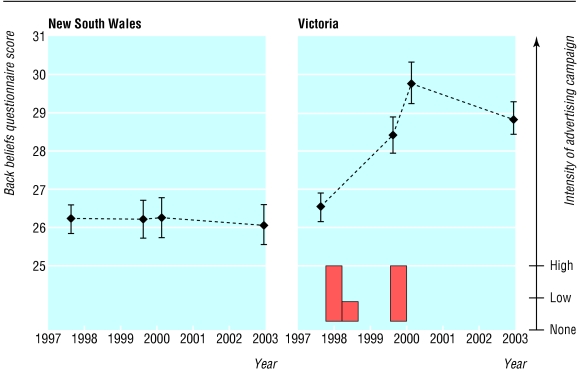We previously reported the positive results of a population based campaign designed to alter beliefs about back pain in Victoria, Australia.1,2 The campaign consisted of television commercials which gave clear advice about back pain—for example, stay active and exercise, do not rest for prolonged periods, and stay at work. After the intervention, doctors' and the community's beliefs about back pain became significantly more positive, and the number of workers' claims for compensation and medical payments for back pain had declined. To measure sustained change in beliefs about back pain three years after the campaign ended, we repeated telephone surveys in Victoria and in adjacent New South Wales as a control.
Participants, methods, and results
We used computer assisted questionnaires given by telephone interview to a random sample of the population of Victoria and New South Wales in December 2002 (aged between 18 and 65 years inclusive and currently employed for at least four hours a week) using the same methods as before.1 No public health interventions for back pain have taken place in either state since the end of 1999.
The primary endpoint was the back beliefs questionnaire, which measures beliefs about the inevitable consequences of future life with low back trouble (possible score 9-45, higher score indicates a more positive belief).3 We analysed data from four population surveys (August 1997, August 1999, February 2000, and December 2002) using standard comparative methods for independent survey data (fig). We treated the back beliefs questionnaire score as a continuous normally distributed quantity. Time (measured as survey 1, 2, 3, or 4) and state were categorical explanatory variables. We compared Victoria with New South Wales with t tests and analysis of variance.
Figure 1.
Mean score from the back pain beliefs questionnaire for New South Wales and Victoria for survey in August 1997, August 1999, February 2000, and December 2002 after media campaign ending in 1999. Error bars show 95% confidence interval. Bar chart shows media campaign (September 1997 to December 1999) with intensity indicated by height of bars
A total of 1500 surveys were completed in December 2002; 900 in Victoria and 600 in New South Wales. Demographic characteristics and previous experience of back pain did not differ between states in survey 4 or compared with previous surveys. Awareness of back pain advertising in Victoria declined between February 2000 and December 2002 (47.1%, 73.9%, 85.5%, and 63.9% at surveys 1, 2, 3, and 4; P < 0.0001) with no changes observed over time in New South Wales (51.2%, 48.5%, 48.0%, and 50.8%).
Population beliefs about back pain in Victoria at survey 4 were less positive when compared to survey 3 but were still significantly better than at baseline and higher than at survey 2 (mean back beliefs questionnaire scores 26.5, 28.4, 29.7, and 28.8 at survey 1, 2, 3, and 4) (figure). Scores in New South Wales did not differ between successive surveys. Victorian beliefs about back pain were still significantly better than beliefs in New South Wales at survey 4 (difference in mean back beliefs questionnaire score 2.72; 95% confidence interval 2.06 to 3.39). For example, Victorians were much more likely to believe that back pain did not necessarily need rest (40.1% v 23.5%; relative risk 1.7, 95% confidence interval 1.5 to 2.0) or mean long periods of time off work (51.4% v 32.8%; 1.6, 1.4 to 1.8).
Comment
Popular beliefs about back pain have remained more positive in Victoria since the end of the media campaign three years ago. This was again seen across the whole distribution of baseline back beliefs, indicating that these views may now be the accepted norm and less effort may be required to maintain this position and achieve long term behavioural change.4,5 However there has been some decay in the observed effect between surveys 3 and 4. Top-up reminders or other strategies may be necessary to maintain improvements over time.
Contributors: Both authors designed the further evaluation of the campaign, did the analyses, interpreted the results, and wrote the paper. RB is guarantor.
Funding: Victorian WorkCover Authority.
Competing interests: None declared.
Ethical approval: Monash University ethics committee.
References
- 1.Buchbinder R, Jolley D, Wyatt M. Population based intervention to change back pain beliefs and disability: three part evaluation. BMJ 2001;322: 1516-20. [DOI] [PMC free article] [PubMed] [Google Scholar]
- 2.Buchbinder R, Jolley D, Wyatt M. 2001 Volvo award winner in clinical studies: effects of a media campaign on back pain beliefs and its potential influence on management of low back pain in general practice. Spine 2001;26: 2535-42. [DOI] [PubMed] [Google Scholar]
- 3.Symonds TL, Burton AK, Tillotston KM, Main CJ. Absence resulting from low back trouble can be reduced by psychosocial intervention at the work place. Spine 1995;20: 2738-44. [DOI] [PubMed] [Google Scholar]
- 4.Rose G. Sick individuals and sick populations. Int J Epidemiol 1985;14: 32-8. [DOI] [PubMed] [Google Scholar]
- 5.Buchbinder R, Jolley D, Wyatt M. Role of the media in disability management. In: Sullivan T, Frank J, eds. Preventing and managing disability at work. London: Taylor and Francis, 2003.



